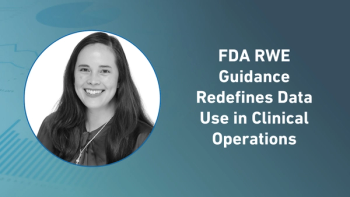
- Applied Clinical Trials-06-01-2018
- Volume 27
- Issue 6
Hope. The Power for the Rare Disease Journey
Editor-in-Chief Lisa Henderson speak about therapeutic needs, rare diseases in children, and the SCORR Marketing survey on innovative or flexible trial designs.
Unfortunately, there is no end to the number of people affected by disease-be they rare, unmet therapeutic needs,
or chronic but manageable. But, everyday, scientists uncover yet another gene, or biomarker, or mechanism of action that leads to the next step in uncovering the true nature of a specific disease, and getting us one step closer to a healthier, longer, or higher quality life.
In addition to advancements in science, are the advancements in drug testing. In this issue, we unveil the results of our trial design survey, conducted with our research partner SCORR Marketing. In that survey (see page 16), respondents shared the types of innovative or flexible trial designs being implemented, primarily but not limited to oncology and rare diseases. By using adaptive or innovative trials, sponsors can theoretically deliver more efficient and faster trials. The FDA and EMA, and other regulatory authorities play a big part in getting rare or orphan drugs through the review process. Starting with scientific advice before a trial is initiated, then offering priority review or other incentives to help sponsors get to the finish line faster.
Children and diagnosis
I wanted to share two recent examples about rare disease in children. The first was my research and interviews with BioMarin for its drug Brineura, approved in April 2017, for the treatment of a specific form of Battan’s disease, CLN2. I wrote about it for Pharmaceutical Executive here:
With Battan, children develop normally until ages two or three, when they experience seizures and progress rapidly to losing the ability to walk and talk by six years of age. After that, symptoms are followed by dementia and blindness; feeding and everyday needs become extremely difficult, and then death occurs between the ages of eight and 12. The video outlines in detail what BioMarin and scientists achieved to get a protein-replacement therapy approved, using one trial of 24 patients with a natural history cohort completed in four years. The drug has only shown to halt the progression, but BioMarin works with commercial lab Invitae to offer a 125-gene panel tests for different types of seizures free of charge. It not only helps diagnose what type of epilepsy may be present, but also diagnose CLN2 in those that were previously undiagnosed.
At the recent Pop-Up Star event, which highlighted programs to increase clinical research awareness, parent Allison Greiner spoke of her son’s journey to date with Duchenne Muscular Dystrophy. After observing his lack of hitting developmental milestones, Matthew was enrolled in physical therapy classes, routine medical exams, and more until his diagnosis almost 16 months later. The first clinical trial ended for lack of efficacy, but now he is enrolled in a Pfizer trial and showing tremendous improvement. Greiner is sure that Matthew will continue to thrive and outlast the expected disease timeline of death in the late 20s, early 30s. Greiner said clinical research offer the hope that these parents and patients need.
Lisa Henderson is Editor-in-Chief of Applied Clinical Trials. She can be reached at
Articles in this issue
over 7 years ago
Gene Therapy in Rare Disease Researchover 7 years ago
Clinical Design: A Deep Diveover 7 years ago
Clinical Trial Evolution: A CRO’s Perspectiveover 7 years ago
Models of Engagement: Patients as Partners in Clinical Researchover 7 years ago
Any Cancer Can Be a 'Rare Cancer'over 7 years ago
Monoclonal Antibodies: Clinical Pharmacology Keysover 7 years ago
Policy and Practice Come Together on EU Vaccine Thrustover 7 years ago
Applied Clinical Trials, June 2018 Issue (PDF)Newsletter
Stay current in clinical research with Applied Clinical Trials, providing expert insights, regulatory updates, and practical strategies for successful clinical trial design and execution.



